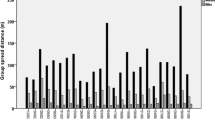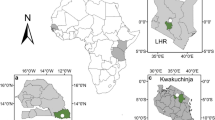Abstract.
Animals are expected to reduce per capita vigilance with increasing group size. Widespread support for this expectation has been found in studies of birds and ungulates. Primate vigilance patterns appear to differ, but studies of primates may have sampled groups with too many members to detect intergroup differences in vigilance. We tested this idea by measuring individual vigilance rates in wild black howler monkeys (Alouatta pigra) living in stable groups of two to ten individuals. No group size effect on vigilance emerged. As in previous studies, inter-individual proximity explained variation in individual vigilance rates. Focal animals with associates within 2 m and with multiple associates in the same tree were less vigilant than isolated animals. Activity and class of focal animals as well as the presence of neonates influenced the average vigilance of adult and subadult black howler monkeys. We conclude that functional explanations must be considered for the general lack of a group size effect on primate vigilance.
Similar content being viewed by others
Author information
Authors and Affiliations
Additional information
Electronic Publication
Rights and permissions
About this article
Cite this article
Treves, A., Drescher, A. & Ingrisano, N. Vigilance and aggregation in black howler monkeys (Alouatta pigra). Behav Ecol Sociobiol 50, 90–95 (2001). https://doi.org/10.1007/s002650100328
Received:
Revised:
Accepted:
Issue Date:
DOI: https://doi.org/10.1007/s002650100328




